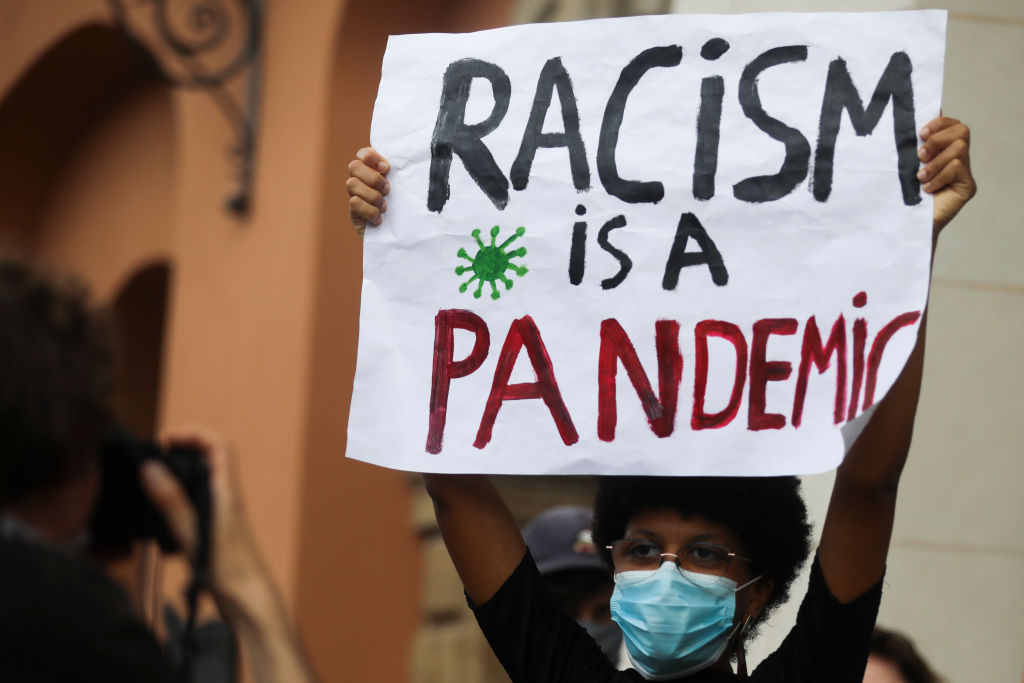Why protesting racism during a pandemic is important: An Epidemiologist explains
Why protesting racism during a pandemic is important: An Epidemiologist explains
Demonstrations have erupted in the UK, Australia, France and several other countries in solidarity with the Black Lives Matter movement and in protest at these countries’ own domestic cases of institutional racism.
The fact that these protests are happening in the middle of a pandemic raises certain issues regarding the spread of the virus, but also they highlight deep inequalities that exist due to structural racism and its effects on people’s health.
It is no coincidence that the people who are most at risk of dying due to institutional racism are also those who are most at risk of COVID-19.
How police tactics endanger protesters
Protests, by their nature, lead to the clustering of large groups of people. Police are dealing with this by crowding people together to control their movements, a tactic known as “kettling”, and spraying tear gas. When protesters are detained, they are often placed in crowded vans and cells.
These conditions are ideal for the transmission of COVID-19. Tear gas irritates mucous membranes, causing people to cough and remove face masks. The proximity of other protesters increases the risk of infection. Additionally, people who are asymptomatic play a large role in infection and increase the possibility of transmission in settings where physical distancing is nearly impossible to observe, such as in jail cells.
 Using tear gas on crowds, as police did in Paris, increases the risk of people contracting COVID-19. Mohammed Badra/EPA
Using tear gas on crowds, as police did in Paris, increases the risk of people contracting COVID-19. Mohammed Badra/EPA
How racism affects health outcomes
Police control tactics at protests may be putting people in danger of catching COVID-19, but the interconnected nature of racism, structural inequalities and health cannot be ignored. Black people are dying at three times the rate of white people in the US due to COVID-19. In the UK, black people are four times more likely to require hospital admission for COVID-19 than white people, while Asian people are three times more likely.
This disparity cannot be blamed on ethnicity-related biological differences alone. There are a number of factors that contribute to unequal COVID-19 outcomes between white people and non-white people, including socioeconomic status and, importantly, racism within health systems.
 Racism within health systems can lead to worse outcomes for people of colour. Andy Rain/EPA
Racism within health systems can lead to worse outcomes for people of colour. Andy Rain/EPA
What we can do about it
There are measures that protesters can take to reduce their risk of infection and transmission at demonstrations. Public health advice is even more important to follow during large gatherings – such as wearing masks, distancing where possible and using hand sanitiser. When protesters return home, they should wash their hands, shower and change clothes. If living with an older relative or someone who is more vulnerable, make sure to isolate from them.
Health authorities should provide COVID-19 tests for people who have attended protests regardless of symptoms, given their risk of exposure. Protesters should also be aware that they may only develop symptoms several days after being infected.
Police can and should change their tactics to reduce COVID-19 infection. Tear gas and pepper spray should not be used at all. Police officers should be wearing masks – to prevent the spread to and from protesters, first responders and to other officers. Corralling people together in close groups should be avoided, as should detaining and arresting protesters. Keeping people out of crowded cells will reduce virus spread in jails and in the community upon release.
Although health authorities are rightly discouraging congregations of people at events such as concerts, sports events and large parties, an exception should be made for protests against systemic racism. These protests may be the only way for the systemically disenfranchised to have their voices heard.
Similar to COVID-19, police killings and structural racism are major threats to public health, and the protests bring these issues to the forefront of public discussion. From an epidemiological perspective, there are certainly risks of increased COVID-19 spread as a direct result of the protests – but the racial disparities in health (which have the same roots as police brutality) and implementation of measures which address these are just as important.
Many protesters are from communities of colour, which have been hardest hit by the effects of the pandemic. They are not acting out of ignorance, but out of necessity.
Written by: Lakshmi Manoharan, Medical Epidemiologist, University of Oxford for The Conversation
Lakshmi Manoharan does not work for, consult, own shares in or receive funding from any company or organisation that would benefit from this article, and has disclosed no relevant affiliations beyond their academic appointment.





